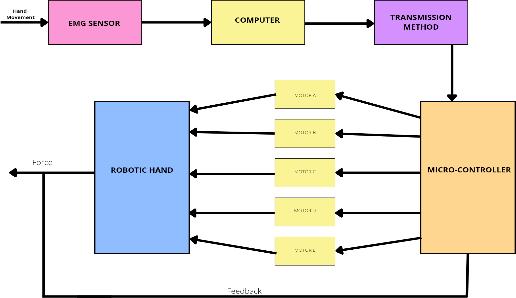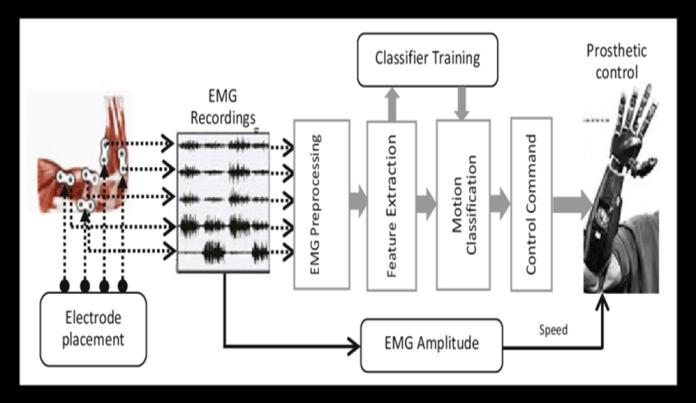International Research Journal of Engineering and Technology (IRJET) e-ISSN: 2395-0056
Volume: 09 Issue: 07 | July 2022
www.irjet.net p-ISSN: 2395-0072

Prosthetic Hand Control Using EMG Sensor
Usman Khan1 , Mainak Roy2
Abstract The idea of this project is to change the perspective of remote controls to manually operated Robotic Hand. In this project we work on the design and development of a Robotic Hand using an Arduino board, and servo motors. The design of the hand is based on a simple, easy, flexible, and minimal controlling strategy. The Robotic Hand has been assigned independent commands for all the five fingers to open and close, pick and place, and to get back to home position. The Arduino based human hand replication system is a system that can help and avoid the human presence to be put under harmful situations such as radioactive and bio hazardous. Thetechnology can also be helpful in very precise instrumentationworkings like a doctor operating a patient with a robot without its own hands. The technology has its many useful applications in the field of robotics, surgical operations, humanoid robots, etc.
Key Words: Arduino, FFRH, Robotic Hand, Replication System
1. INTRODUCTION
The term "prosthetic" comes from a new Latin word from Greek "prostithenai" meaning "to add to, or to put in addition", this describes the addition of an artificial bodypart,suchasalimb,aheart.Thehumanupperlimb isanimportantpart ofthe body,thepartial orcomplete loss of which can have a serious effect on a person's ability on the day to day activities. The human upper limb has three sections the hand, forearm, and arm. For the movement of each section, coordination of the nervous system, musculoskeletal systems, and its surroundings is necessary. To perform various daily activities,coordinationofdifferentjoints(shoulder,elbow, wrist, and finger joint) is essential, including a broad rangeofmotionswithseveraldegreesoffreedom.These coordinatedmovementsarenotalwaysredundantandcan be beneficial to perform complex tasks. When it comes to an artificial hand, all the control features of the normal hand should extensively match, so that the user can perform their daily needs in a modified and effectiveway. The coordinated control of the biological handis quite complex, making it highly difficult to replicate it exactly inanyprosthetichand.
Most of the systems are designed for people who lost their handorleginanaccident orwhoarehandicapped by birth.With 3D printed prosthetics gaining popularity with the advent of consumer level 3D printers, practical applications of these prosthetics have also been
increasing. Online open source development has allowed for printable hand modelsto be downloadedforfree within minutes from websites such as Thingiverse, a free, open source 3D modeling site. Contrary to traditional prosthetics, which often cost tens of thousands of dollars and are usually unaffordable to many, these alternatives provide a relatively inexpensive option tothe public. This allows for less expensive, yet effective prosthetics to be available to modern consumers, with increased personalization for the user at a speed unachievable by conventionalmethods.
Objective
Itishelpfulforthepeoplewhohavelostoneoftheir handsorifitisparalyzed.
Lowcost.Thewholehand canbemanufacturedfor 200 USD, which makes it very affordable in comparisonsto its present contemporary robotic handproposal.
Highlyeffective
TheLightweight3Dprintedmodules/parts,makesit veryeasyfortheusertocarryitaroundwiththem.
Safetouse
Easyoperate
It can be further modified. It can be custom made dependinguponhowtheuserwantsittofunction.It caneven becontrolledthroughcloudorWi Fi.
Need of the Project
In the United States, there are approximately 40,000+ persons who have lost their major upper-limb or have it paralyzed. Activities that a person could routinely perform may no longer be possible or may require additional effort and time due to upper limb amputation. Upperlimbprosthesescanassistamputeesinactivitiesof daily living such as feeding, dressing, and hygiene tasks. These performance capabilities are highly desired by persons with upper-limb amputation, regardless of their amputation level or current prosthesis type. Unfortunately,duetothelimitationsofclinicallyavailable prosthetics technologies, a substantial proportion of persons with upper limb amputation (10 25%) do not use prosthesis. Of those patients that do use prosthesis,
© 2022, IRJET | Impact Factor value: 7.529 | ISO 9001:2008 Certified Journal | Page2601
B.Tech (ESE) National Institute of Electronics and I.T, Aurangabad (Maharashtra), India
***
International Research Journal of Engineering and Technology (IRJET) e-ISSN: 2395-0056



Volume: 09 Issue: 07 | July 2022 www.irjet.net p-ISSN: 2395-0072
only approximately 50% of subjects use an electric prosthesis. Improving prosthetic technology in ways that yieldappreciable benefits in tasks that amputees identify as important, such as ADLs, is essential to increase acceptance rates of electric prostheses and, ultimately, improvequalityoflifepost-amputation.

2. METHODOLOGY
The following block diagram of the proposed system, which includes Arduino UNO, regulated power supply, fourservo motors(MG995), andoneservomotor(SG90). Arduino boards are broadly used because it has the featurethatitcanreadvarioustypesofinputlikelighton a sensor, pressing of a button by finger and turning ON/OFF of a motor/LED, etc. So, this board is very suitableforthis project. Inthis system, theMG995 servo motorisusedbecauseitprovideslowspeedwiththeexact position which is very important for the useful functioning of the hand. Servo motors are present in many sizes and shapes. Servo motors have three wires oneisforpowersupply,oneisforgroundandonemoreis forangularrotation(0 180degree)readings and this wire oftheservomotorisconnectedtotheArduinoboard.
3. SYSTEM DEVELOPMENT
ListofComponentsusedinthisproject:

Fig2.1 Experimental Setup
ServoMotor(MG995) © 2022, IRJET | Impact Factor value: 7.529 | ISO 9001:2008 Certified Journal | Page2602
3DPrintedProstheticHand EMGSensor
International Research Journal of Engineering and Technology (IRJET) e-ISSN: 2395-0056

Volume: 09 Issue: 07 | July 2022 www.irjet.net p-ISSN: 2395-0072
BLOCK DIAGRAM
5. ASSEMBLY
Step by step procedure to assemble the hand:
Step 1: Allfingersexceptthethumbareassembledfromthe fingertip,joint,andknuckle.Thestringisusedtojointhese parts.Thumbisassembledfromthethumbjoint,thumbtip, andjoint.
Step 2: Four Servo motors are placed in the Forearm region andtightenedwithascrewprovidedwiththeservomotor. Threads are connected to the servo on the horns. The infant fingerandtheringfingerareconnectedtoasimilarservo,as they provide the same functionality. Four Gesture RecognitionofaRoboticHandusingEMG.

Step 3: Cutten 20 inches of fishing line.Two fishinglines perfingerareused.Crimpthembyfeedingthefishingline fromoneside.Feedthefishinglinefromthefingertipstill thefishinglineexistsfromthepalm.
Step 4: Nowthefishinglineisattachedtothecorresponding servomotor.Thefishinglineshouldbetensioned.Tocheck the fishing line is tension's move. The motor is counter clockwisewiththehandandthefingerwillmoveinward.By rotatingitclockwisethefingershouldopen.
Step 5: Now stick the electrode pads and then connect Arduino with motors and place the forearm cover on the forearmbody.
6. PROGRAM
The following code is for the Electromyography Sensor: intEMGPin=A0; intEMGVal=0;

void setup() { Serial.begin(9600); } voidloop(){ EMGVal=analogRead(EMGPin); Serial.println(EMGVal); }
The following code is for making a wrist:
#include <Servo.h> int EMGPin = A1; int EMGVal = 0; Servo servo1; Servo servo2; Servo servo3; Servo servo4; Servoservo5; const int servoPin1 = 3; const int servoPin2=5;const int servoPin3 = 6; const int servoPin4 = 9; const int servoPin5=10;
void setup() { Serial.begin(9600); servo1.attach(servoP in1); servo2.attach(servoP in2); servo3.attach(servoP in3); servo4.attach(servoP in4); servo5.attach(servoP in5); servo1.write(0);//pi
4.
© 2022, IRJET | Impact
|
Certified Journal | Page2603
Factor value: 7.529
ISO 9001:2008
International Research Journal of Engineering and Technology (IRJET) e-ISSN: 2395-0056 p-ISSN: 2395-0072

Volume: 09 Issue: 07 | Jul 2022 www.irjet.net
servo3.write(1 80); servo2.write(0 ) servo4.write(0 ); servo5.write(0 ); delay(2000); servo1.detach( ); servo3.detach( ); servo2.detach( ); servo4.detach( ); servo5.detach( );delay(2000);
}
nky delay(1000); servo1.detach(); servo2.write(180);//midd le delay(1000); servo2.detach(); servo3.write(0);//thumb delay(1000); servo3.detach(); servo4.write(180);//4 delay(1000); servo4.detach(); servo5.write(180);//5 delay(1000); servo5.detach(); } voidloop(){ //**************** FOR READING OF EMG
=analogRead(EMGPin); Serial.println(EMGVal); delay(20);
if(EMGVal>=120&&EMGVal<=200) { //**************** FOR CLOSING OF FINGERS **********************servo1.attach(servoPin1); servo2.attach(servoPin2); servo3.attach(servoPin3); servo4.attach(servoPin4); servo5.attach(servoPin5); servo1.write(180);
if(EMGVal>=50&&EMGVal<=100) { //**************** FOR OPNING
OF FINGERS
servo1.attach(s ervoPin1); servo2.attach(s ervoPin2); servo3.attach(s ervoPin3); servo4.attach(s ervoPin4); servo5.attach(s ervoPin5); servo1.write(0); servo3.write(0); servo2.write(18 0); servo4.write(18 0); servo5.write(18 0); delay(2000); servo1.detach(); servo3.detach(); servo2.detach(); servo4.detach(); servo5.detach(); delay(2000); }


//***** FOR TESTING UNCOMMENT IT AND COMMENT ALL*****
// servo1.attach(servoPin1); // servo2.attach(servoPin2); // servo3.attach(servoPin3); // servo4.attach(servoPin4); // servo5.attach(servoPin5); // servo1.write(130); // servo3.write(0); // servo2.write(0); // servo4.write(0); // servo5.write(160); // delay(2000); // servo1.write(0); // servo3.write(180); // servo2.write(200); // servo4.write(180); // servo5.write(0); // delay(2000); // servo1.detach(); // servo3.detach(); // servo2.detach(); // servo4.detach(); // servo5.detach(); // delay(2000);
**********************EMGVal
//*********************************************************** **********
**********************
© 2022, IRJET | Impact
| ISO
Certified Journal | Page2604
Factor value: 7.529
9001:2008
International Research Journal of Engineering and Technology (IRJET)




Volume: 09 Issue: 07 | Jul 2022 www.irjet.net
In this project, we have designed and developed the lightweight3D printedprostheticrobotichandwhichworks on Arduino UNO, Servo motor, and EMG sensor. The Arduino boardisprogrammedinsuchawaythatthewholesystemis controlled to perform the daily life activities. This system helps the disabled person to overcome their obstacles in daily life and it also have many applications in manufacturing industries, the medical field, and many more.The proposed model is of low cost and the hardware componentsofthesystemareeasilyavailable.
ACKNOWLEDGEMENT
We would like to express our special thanks to our guide Scientist/Engineer ‘B’ Prashant Pal and co guide Scientist/Engineer ‘C’ Saurabh Kesari for his advice and encouragement,whichhasgreatlybenefitedthispaper.We alsothankNationalInstituteofElectronicsandInformation Technology, Aurangabad for having all the necessary resources and facilities that significantly enhanced this manuscriptwithsupportandlaboratory
REFERENCES
[1] Sivapong Nilwong, Delowar Hossain, Eneo Petoku, and GenciCapi“DevelopmentofMyoelectricRoboticHandusing 3D Printer“, 1st International Conference on Advances in Science, Engineering and Robotics Technology 2019 (JCASERT2019)

[2]VaibhavPawar,SnehaBire,ShubhamMore,KomalMore and Reshma Mule, “Review on Design and Development of Robotic Arm Generation 1”, International Journal of InnovativeScienceandResearchTechnology,pp.529,March 2018
e-ISSN: 2395-0056 p-ISSN: 2395-0072
[3]TranVanhuy,DaoTuanMinh,KienNguyenPhanandVu Anh Tran, “Simple Robotic Hand in Motion Using Arduino Controlled Servos”, International Journal of Science and Research(IJSR),pp.972 974,March2017.
[4]KobayashiH,IshidaY,SuzukiH,“Realizationofallmotion for the upper limb by a muscle suit”, IEEE International WorkshoponRobotandHumanInteractiveCommunication, Japan,September2004
[5] IasonBatzianoulis,AudeBillard,NiliE.Krausz,AnnM. Simon & Levi Hargrove, “Decoding the grasping intention from electromyography during reaching motions” Batzianoulis et al. Journal of Neuro Engineering and Rehabilitation 2018 [6] J.B. Gupta, Electronic Devices and Circuits,S.K.Kataria&Sons,2009
BIOGRAPHIES
Usman Khan ,B.Tech 4th year (ESE) NationalInstituteofElectronicsand I.T,Aurangabad(Maharashtra),India




Mainak Roy, B.Tech 4th year (ESE) NationalInstituteofElectronicsand I.T,Aurangabad(Maharashtra),India
Prashant Pal, Scientist/Engineer ‘B’NationalInstituteof Electronics and I.T,Aurangabad(Maharashtra), India
Saurabh Kesari, Scientist/Engineer ‘C’ National Institute of Electronics and I.T, Aurangabad(Maharashtra), India
7. CONCLUSION © 2022, IRJET | Impact Factor value: 7.529 | ISO 9001:2008 Certified Journal | Page2605

















